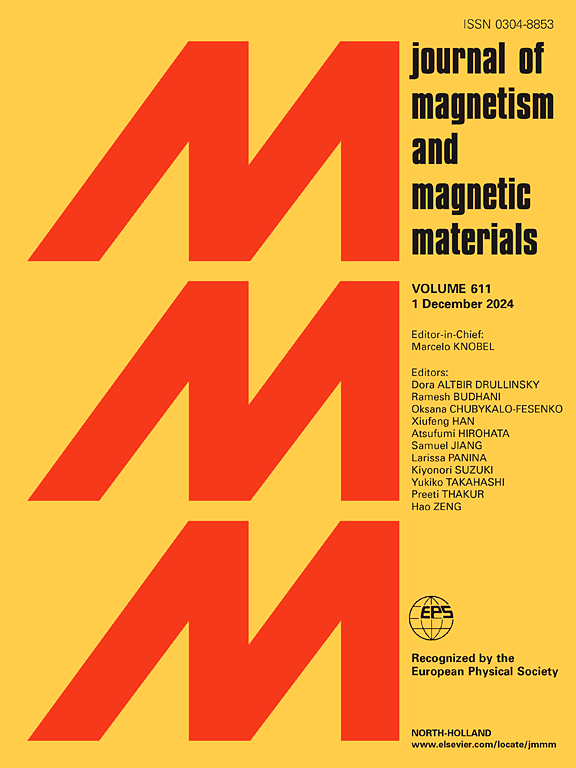二维铁磁TiCTe3单层作为量子反常霍尔效应的有趣平台
IF 2.5
3区 材料科学
Q3 MATERIALS SCIENCE, MULTIDISCIPLINARY
引用次数: 0
摘要
长期以来,追求具有本征量子反常霍尔(QAH)效应的二维(2D)铁磁(FM)材料一直是一个重要的目标,因为它对探索新的物理现象和推进下一代自旋电子器件具有深远的意义。在此,基于第一性原理计算,我们预测二维FM TiCTe3单层是具有优异热力学稳定性的固有QAH绝缘体。该单层膜具有垂直磁各向异性,每个Ti原子的磁晶各向异性能(MAE)为139.00 μeV。在没有自旋轨道耦合(SOC)的情况下,单分子膜表现出狄拉克半金属行为。当包含SOC时,实现了37.40 meV的非寻常带隙开口,导致出现了以陈恩数C =−1为特征的QAH效应,并且在体带隙内出现了完全自旋极化的边缘状态。同时,双轴应变可以有效地控制TiCTe3单层的MAE和非平凡带隙。这些发现为纳米电子学和自旋电子学的广泛应用提供了一个非常有前途的平台。本文章由计算机程序翻译,如有差异,请以英文原文为准。
Two-dimensional ferromagnetic TiCTe3 monolayer as an intriguing platform for quantum anomalous Hall effect
The pursuit of two-dimensional (2D) ferromagnetic (FM) materials that harbor the intrinsic quantum anomalous Hall (QAH) effect has long been an important objective, given its profound implications for exploring novel physical phenomena and advancing next-generation spintronic devices. Herein, based on first-principles calculations, we predict that the 2D FM TiCTe3 monolayer is an intrinsic QAH insulator with excellent thermodynamic stability. The monolayer exhibits perpendicular magnetic anisotropy, accompanied by a magnetocrystalline anisotropy energy (MAE) of 139.00 μeV per Ti atom. In the absence of spin–orbit coupling (SOC), the monolayer demonstrates Dirac half-metallic behavior. When the SOC is included, a nontrivial band gap opening of 37.40 meV is achieved, resulting in the emergence of the QAH effect characterized by Chern number C = − 1 and fully spin-polarized edge states within the bulk band gap. Meanwhile, the MAE and nontrivial band gap of the TiCTe3 monolayer can be effectively manipulated by biaxial strain. These findings provide a remarkable and promising platform that is expected to have broad applications in nanoelectronics and spintronics.
求助全文
通过发布文献求助,成功后即可免费获取论文全文。
去求助
来源期刊

Journal of Magnetism and Magnetic Materials
物理-材料科学:综合
CiteScore
5.30
自引率
11.10%
发文量
1149
审稿时长
59 days
期刊介绍:
The Journal of Magnetism and Magnetic Materials provides an important forum for the disclosure and discussion of original contributions covering the whole spectrum of topics, from basic magnetism to the technology and applications of magnetic materials. The journal encourages greater interaction between the basic and applied sub-disciplines of magnetism with comprehensive review articles, in addition to full-length contributions. In addition, other categories of contributions are welcome, including Critical Focused issues, Current Perspectives and Outreach to the General Public.
Main Categories:
Full-length articles:
Technically original research documents that report results of value to the communities that comprise the journal audience. The link between chemical, structural and microstructural properties on the one hand and magnetic properties on the other hand are encouraged.
In addition to general topics covering all areas of magnetism and magnetic materials, the full-length articles also include three sub-sections, focusing on Nanomagnetism, Spintronics and Applications.
The sub-section on Nanomagnetism contains articles on magnetic nanoparticles, nanowires, thin films, 2D materials and other nanoscale magnetic materials and their applications.
The sub-section on Spintronics contains articles on magnetoresistance, magnetoimpedance, magneto-optical phenomena, Micro-Electro-Mechanical Systems (MEMS), and other topics related to spin current control and magneto-transport phenomena. The sub-section on Applications display papers that focus on applications of magnetic materials. The applications need to show a connection to magnetism.
Review articles:
Review articles organize, clarify, and summarize existing major works in the areas covered by the Journal and provide comprehensive citations to the full spectrum of relevant literature.
 求助内容:
求助内容: 应助结果提醒方式:
应助结果提醒方式:


